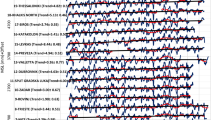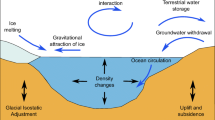Abstract
It is well-known that North Atlantic Oscillation (NAO), which is one of the large-scaled climate modes effective in the Northern Hemisphere, has a considerable affect on the water resources and climatic indicators especially in the Mediterranean basin. In recent years, also crucial studies about the sea level rise in relation to climate change have been accelerated. Turkey has about 20 modernized tide gauge stations equipped with permanent GPS receivers and targets to contribute to global sea level rise studies in the future. The aim of this study is to find out the effects of North Atlantic Oscillation on the national shores using the data of four tide-gauge stations located on the Aegean and Mediterranean coasts of Turkey. Implications from these four tide gauges would motivate researches to take into account the effect of NAO in calculating the true sea level rise at the national coasts. While studying the sea level changes, vertical crustal movement has been observed using the data of tide gauge GPS stations, and this situation has been taken into consideration in the evaluation of sea levels. Besides, in order to investigate the influences of thermal expansion on sea levels, sea surface temperature data of the meteorology stations near the tide gauges have been evaluated. The homogeneity of the data sets was analyzed using four statistical tests. As a result, all of the meteorology stations’ temperature series and tide gauges’ data are subjected to trend detection after the homogeneity analysis. Eventually, the effects of North Atlantic Oscillation on both sea levels and sea surface temperatures have been introduced. The study results indicate high correlation between North Atlantic Oscillation and the sea level and sea surface temperature events. It is seen that the linear correlation between the sea level trends of the considered stations and the sea surface temperature data of the related meteorology stations is considerably significant.






Similar content being viewed by others
References
Aldeanueva FC, Vera JDR, Lafuente JG (2008) Steric and mass-induced Mediterranean sea level trends from 14 years of altimetry data. Glob Planet Chang 60:563–575
Aravena G, Villate F, Iriarte A, Uriarte I, Ibanez B (2009) Influence of the north Atlantic oscillation (NAO) on climatic factors and estuarine water temperature on the Basque coast (Bay of Biscay): comparative analysis of three seasonal NAO indices. Cont Shelf Res 29:750–758
Becker M, Karpytchev M, Davy M, Doekes K (2009) Impact of a shift in mean on the sea level rise: application to the tide gauges in the Southern Netherlands. Cont Shelf Res 29:741–749
Cheng X, Qi Y (2007) Trends of sea level variations in the South China Sea from merged altimetry data. Glob Planet Chang 57:371–382
Church JA, White NJ (2006) A 20th century acceleration in global sea level rise. Geophys Res Lett 33:L01602. doi:10.1029/2005GL024826
Church JA, White NJ, Hunter JR (2006) Sea level rise at tropical Pacific and Indian Oceans Islands. Glob Planet Chang 53:155–168
Dippner JW, Junker K, Kröncke I (2010) Biological regime shifts and changes in predictability. Geophys Res Lett 37:L01602. doi:10.1029/2010GL045696
Douglas EM, Vogel RM, Kroll CN (2000) Trends in floods and low flows in the United States: impact of spatial correlation. J Hydrol 240:90–105
Ginzburg AI, Kostianoy AG, Sheremet NA (2004) Seasonal and interannual variability of the Black Sea surface temperature as revealed from satellite data (1982–2000). J Mar Syst 52:33–50
Holgate SJ, Woodworth PL (2004) Evidence for enhanced sea level rise during the 1990s. Geophys Res Lett 31:1–4
Kazmin AS, Zatsepin AG (2007) Long term variability of surface temperature in the Black Sea, and its connection with the large scale atmospheric forcing. J Mar Syst 68:293–301
Kulkarni A, Von Storch H (1995) Monte-Carlo experiments on the effect of serial correlation on the Mann-Kendall test of trend. Meterologische Z 4(2):82–85
Oğuz T (2005) Black Sea ecosystem response to climatic variations. Oceanography 18(2):122–133
Oğuz T, Dippner JW, Kaymaz Z (2006) Climatic regulation of the Black Sea hydro-meteorological and ecological properties at interannual-to-decadal time scales. J Mar Syst 60:235–254
Revelle R (1983) Probable future changes in sea-level resulting from increased atmospheric carbon dioxide. National Academy Press, Washington, pp 433–449, Changing Climate, 8. Chapter
Rodionov SN (2004) A sequential algorithm for testing climate regime shifts. Geophys Res Lett 31:L09204. doi:10.1029/2004GL019448
Rong Z, Liu Y, Zong H, Cheng Y (2007) Interannual sea level variability in the South China Sea and it response to ENSO. Glob Planet Chang 53:257–272
Swanson KL, Tsonis AA (2009) Has the climate recently shifted? Geophys Res Lett 36:L06711. doi:10.1029/2008GL037022
Titus JG, Prk RA, Leathermn SP, Weggel JR, Greene MS, Mausel PW, Brown S, Gaunt G, Trehan M, Yohe G (1991) Greenhouse effect and sea level rise: the cost of holding back the Sea. Coast Manag 19:171–204
Tsimplis MN, Shaw AGP (2008) The forcing of mean sea level variability around Europe. Glob Planet Chang 63:196–202
Unnikrishnan AS, Shankar D (2007) Are sea level rise trends along the coasts of the north Indian Ocean consistent with global estimates? Glob Planet Chang 57:301–307
Van Storch H, Navarra A (1995) Analysis of climate variability-applications of statistical techniques. Springer, New York
Wang W, Wang D, Qi Y (2000) Large scale characteristics of interannual variability of sea surface temperature in the South China Sea. Acta Oceanol Sin 22:8–16
Wang C, Wang W, Wang D, Wang Q (2006) Interannual variability of the South China Sea associated with El Nino. J Geophys Res 111:C03023. doi:10.1029/2005JC003333
Yasunaka S, Hawana K (2002) Regime shifts found in the Northern Hemisphere SST field. J Meteorol Soc Jpn 80(1):119–135
Yildiz H, Andersen OB, Simav M, Aktug B, Ozdemir S (2013) Estimates of vertical land motion along the southwestern coasts of Turkey from coastal altimetry and tide gauge data. Adv Space Res 51:1572–1580
Yu YS, Zau S, Whittemore D (1993) Nonparametric trend analysis of water quality data of rivers in Kansas. J Hydrol 150:61–80
Zhang X, Harvey KD, Hogg WD, Yuzyk TR (2001) Trends in Canadian streamflow. Water Resour Res 37(4):987–998
Author information
Authors and Affiliations
Corresponding author
Rights and permissions
About this article
Cite this article
Dogan, M., Cigizoglu, H.K., Sanli, D.U. et al. Investigation of sea level anomalies related with NAO along the west coasts of Turkey and their consistency with sea surface temperature trends. Theor Appl Climatol 121, 349–358 (2015). https://doi.org/10.1007/s00704-014-1247-3
Received:
Accepted:
Published:
Issue Date:
DOI: https://doi.org/10.1007/s00704-014-1247-3




